In addition to land mammals, some mammals live in the ocean. These ocean and sea mammals have lungs for breathing and some other common similarities, like the land mammals.
However, all sea mammals don’t belong to the same family. I will discuss the 9 ocean and sea mammals in detail in this article. Let’s dive in.
9 Ocean and Sea Mammals
Here are the details of the 9 ocean and sea mammals.
Whale

Whales are the largest animals to ever live on Earth. They belong to the Cetacea family and are divided into two main groups – baleen whales and toothed whales. Some of the most popular whale species include the blue whale, humpback whale, sperm whale, and grey whale.
These mammals are generally found in all the oceans of the world. They feed mostly on plankton and fish and communicate with each other through clicks and whistles.
Dolphin
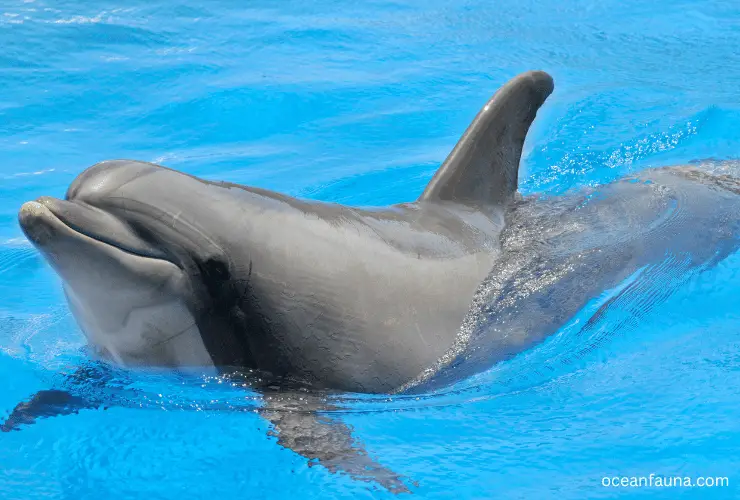
Dolphins are aquatic mammals that belong to the Delphinidae family. They are closely related to whales and porpoises and live in warm oceans worldwide.
They have a streamlined body shape with flippers for better movement in the water. Also, they have an acute sense of hearing which helps them to locate their prey quickly. Dolphins communicate through whistles, jumps, clicks, and other sounds.
There are different types of dolphins, such as bottlenose dolphins, short-beaked common dolphins (the fastest dolphins), and killer whales (the top ocean predators). Remember that not all dolphins live in the ocean, as some species can be found in freshwater habitats, like the Amazon River dolphin and the South Asian River dolphin.
Porpoise
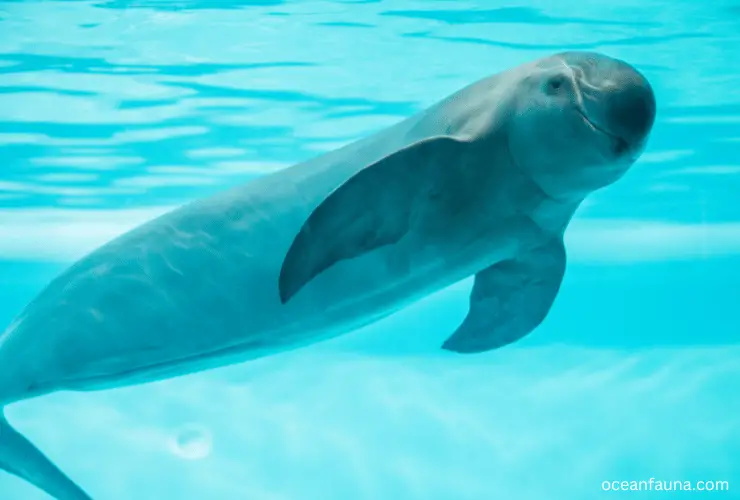
Porpoises are small aquatic mammals that belong to the Phocoenidae family. They mostly live in shallow coastal waters and estuaries. Remember, porpoises and dolphins have several differences.
They have a robust body shape with a rounded head, flat snout and flippers for better movement in the water. Their eyes are adapted for low-light vision and have a well-developed sense of hearing.
Porpoises communicate with each other using clicks and whistles and feed on small aquatic creatures like fish, squid, and octopus. Some popular porpoise species include harbour porpoises, Dall’s porpoises, and spectacled porpoises. Also, the vaquita, a porpoise species, is critically endangered and is only present in the northern part of the Gulf of California, located in Baja, California, Mexico.
Sea Otter
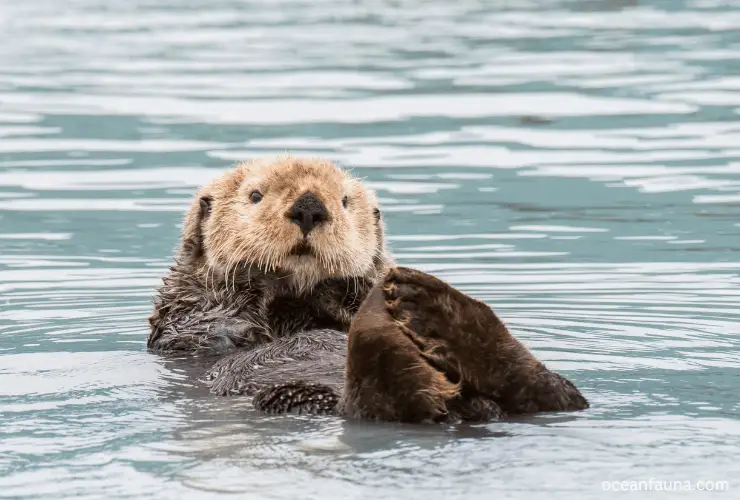
Sea otters are aquatic mammals that belong to the Mustelidae family. They have thick fur, which helps them stay warm in the water, and two large webbed feet, which help them swim.
Sea otters feed mainly on molluscs and crustaceans, but they also eat some fish. They live along the coastlines of the Pacific Ocean, from Russia to Alaska and California to Mexico.
These animals usually communicate with each other through whistles, chirps and growls and live in large colonies of up to 300 individuals. Sea otters are now listed as threatened due to hunting, oil spills and pollution.
Sea Lion
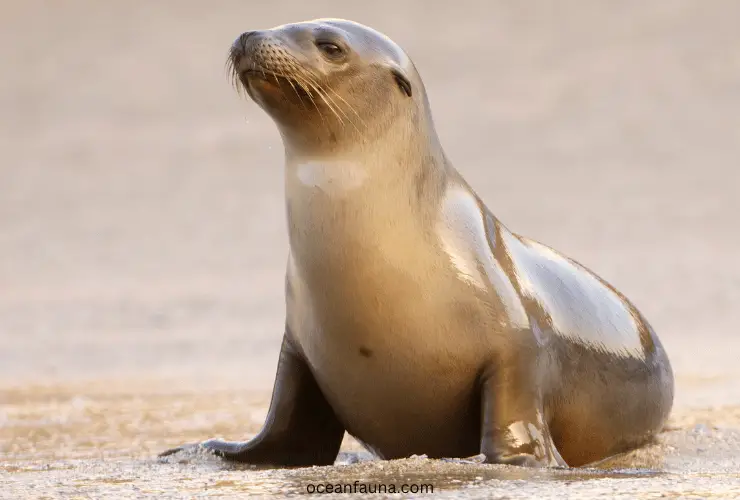
Sea lions are large aquatic mammals that live in the Pacific Ocean and belong to the Otariidae family. They have a thick layer of blubber which helps them to stay warm in cold water.
They also have short fur and a well-developed sense of hearing and vision. Sea lions feed on different types of fish, squid and crabs.
There are two types of sea lions – the eared seals (or just “seals”) and the true seals. The most popular species include the California sea lion, Steller sea lion, Galapagos sea lion, and Australian sea lion.
These animals usually prefer to live in large colonies and communicate through barking, moaning, groaning, and other sounds.
Walrus
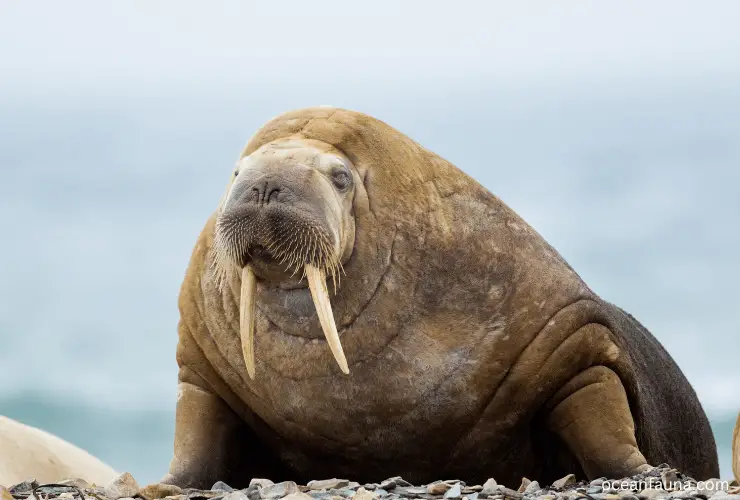
Walruses are large aquatic mammals that belong to the Odobenidae family. They have two big tusks, a thick layer of blubber for insulation and two flippers for better movement in the water.
There is often confusion between walruses, seals and sea lions, but one key difference is that only walruses have tusks which can be found in both males and females. Apart from tusks, walruses share some similarities with seals and sea lions. For instance, they can also bark and can stay underwater for extended periods.
Walruses usually feed mostly on clams and other small shellfish, but they also eat fish and shrimp. Walruses live in large herds near Russia, Alaska, Canada, and Greenland coasts.
The population of walruses is decreasing due to climate change, overfishing and hunting. Therefore, they are now listed as a vulnerable species.
Seal
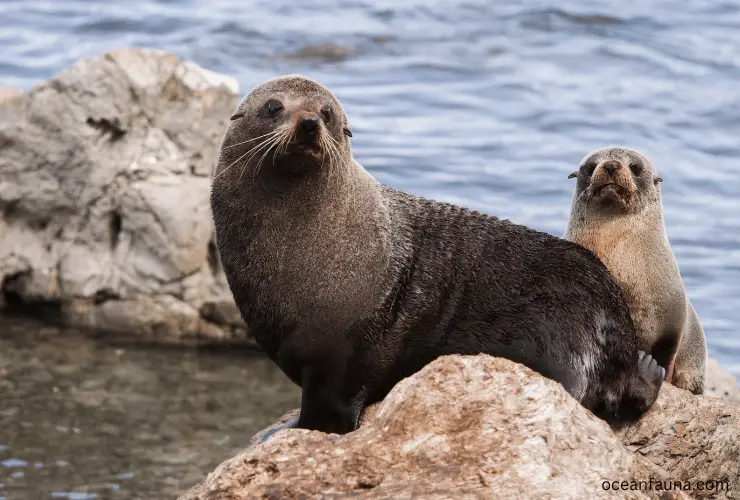
Seals are medium-sized aquatic mammals that belong to the Phocidae family. They are also known as “eared seals” and have special features like a thick layer of blubber and webbed feet for better movement in the water.
Unlike walruses, they don’t have tusks but long whiskers, which help them sense their prey’s presence. Seals also have a well-developed sense of hearing and vision, which helps them to locate their prey quickly.
There are different types of seals, such as harbour seals, monk seals, harp seals, elephant seals, and Weddell seals. These animals feed on fish, squid, octopus and other aquatic creatures. They prefer to live in large colonies near Northern Europe, North America, and Antarctica coastlines.
Manatee

Manatees are large aquatic mammals that belong to the Sirenia family. They are also known as “Sea Cow.” They have a streamlined body shape with two forelimbs that look like flippers and a paddle-shaped tail for better movement in the water.
Manatees have a thick layer of blubber which helps them to stay warm in cold water. They feed on aquatic plants and communicate with each other through clicks, whistles, and squeaks.
The most popular manatee species are the West Indian manatee (which is found in the coastal waters of the USA, Mexico and Central America), the Amazonian manatee (which is found in South America) and the West African manatee (which is found in western Africa).
Dugong
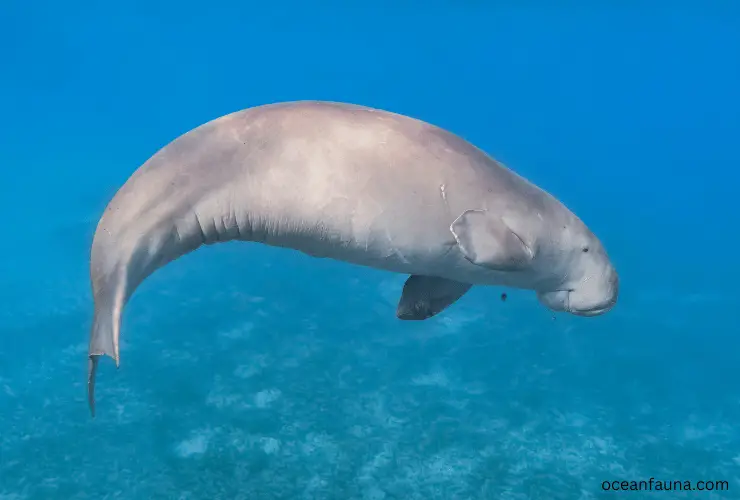
Dugongs are large aquatic mammals that belong to the Dugongidae family. They have a thick layer of blubber, two forelimbs that look like flippers and a tail for better movement in the water. Dugongs also have a well-developed sense of hearing and vision.
It can be difficult to tell the difference between dugongs and manatees at a glance. These two marine mammals are closely related and share many physical and behavioural traits.
However, one important distinction is the shape of their tails. Manatees have broad, paddle-shaped tails, while dugongs have narrower, more pointed tails resembling whales.
Dugongs feed mainly on sea grasses but also consume fish, crabs, and other aquatic animals. They prefer to live in shallow coastal waters and estuaries and communicate through various vocalizations. Dugongs are now listed as an endangered species due to habitat loss, pollution, overfishing and hunting.
Do All Marine Mammals Have Lungs?
Yes, all marine mammals have lungs. This is one of the defining characteristics of marine mammals and distinguishes them from other marine creatures, such as fish, crustaceans, and molluscs that rely on gills to extract oxygen from the water.
Having lungs allows marine mammals to breathe air directly from the atmosphere while submerged in water, which is essential for their survival. Lungs are highly specialized organs that have evolved to adapt to the unique requirements of life in the marine environment.
Unlike terrestrial mammals, marine mammals need to conserve oxygen while diving for extended periods and experiencing increased pressure at depth.
They have developed several adaptations to enhance their lung capacity and efficiency, such as having larger and more flexible lungs, higher concentrations of oxygen-binding proteins in their blood, and the ability to collapse their lungs to reduce buoyancy and extend their dive time.
Furthermore, some marine mammals have developed specialized respiratory structures that allow them to stay submerged for extended periods while still being able to breathe. For instance, whales and dolphins have blowholes on top of their heads, enabling them to take in air without fully surfacing.
What Is the Largest Marine Mammal?
The largest marine mammal on the planet is the Antarctic blue whale (Balaenoptera musculus ssp. Intermedia). This incredible creature can weigh up to 400,000 pounds, which is roughly equivalent to the weight of 33 adult elephants. In terms of length, the Antarctic blue whale can reach up to an astonishing 98 feet long.
To put this into perspective, humans typically only reach a height of around 6 feet. This means that the Antarctic blue whale is more than 16 times longer than the average adult human! It’s truly amazing to think that such a massive creature exists in our oceans.
In addition to its impressive size, the Antarctic blue whale is also known for its distinctive blue-grey colouration, which can be seen on its dorsal side. These whales have a mottled appearance, with white or light grey markings on their underbelly.
Unfortunately, the Antarctic blue whale has been heavily hunted in the past, and its population has declined significantly as a result. However, efforts are now being made to protect and conserve this incredible animal so that future generations can continue to marvel at its size and beauty.
What Is the Fastest Marine Mammal?
The fastest marine mammal is the short-beaked common dolphin (Delphinus delphis). This amazing marine animal can reach speeds of up to 60 km/h (37 mph), making it the fastest known marine mammal. This impressive ability allows dolphins to easily outrun most predators, making them a formidable force in the ocean.
Not only are dolphins incredibly fast, but they are also playful swimmers. They can often be seen riding swells and ship’s wakes, using their speed and agility to perform acrobatic movements that leave onlookers in awe.
Their playful nature also makes them more approachable to humans, leading to their popularity as a popular attraction in places like marine parks and aquariums.
Dolphins’ streamlined body shape helps them move quickly through the water. They also have a unique air supply system that allows them to hold their breath for extended periods, up to 15 minutes in some cases. This allows them to dive deep into the ocean and hunt for prey, making them successful hunters as well as fast swimmers.
In addition to their speed and playful behaviour, dolphins are also known for their intelligence and social behaviour. They are highly intelligent animals that have been observed using tools and working together to solve problems.
They also have strong social bonds and communicate with each other using a variety of sounds and body language.
What Is the Deadliest Marine Mammal?
The killer whale, also known as the Orca, is undeniably the deadliest marine mammal in the world. These apex predators are highly intelligent and powerful and have no natural enemies in the ocean. Their speed, hunting tactics, and physical characteristics make them a force to be reckoned with.
Killer whales are known to hunt and kill various marine mammals, such as seals, sea lions, and even large baleen whales. They have been observed working together in groups, or pods, to take down their prey. Their hunting techniques include stunning their prey with their powerful tail flukes or ramming them with their massive bodies from below.
In addition to their lethal hunting abilities, killer whales’ size and strength make them a serious threat to humans. Although attacks on humans are rare, there have been several documented cases of orcas attacking boats and injuring or killing people.
Furthermore, killer whales can travel long distances and be found in the world’s oceans, from the Arctic to the Antarctic. They have a diverse diet and adapt quickly to changes in their environment, making them a highly adaptable and successful predator.
Remember, the killer whale’s status as the deadliest marine mammal does not make them inherently evil or malicious. They are complex and highly intelligent creatures that play a vital role in maintaining marine ecosystems. Understanding and respecting their behaviour and habitat is crucial to ensure their continued survival and our safety as well.
Conclusion
I hope you have a good understanding of all the ocean and sea mammals discussed above. Currently, we know of 9 types of these mammals. However, there may still be more marine mammals waiting to be discovered and studied.
Each marine mammal species is unique and has remarkable traits. From the largest, the Antarctic blue whale, to the fastest, the short-beaked common dolphin, these animals have evolved impressive adaptations that allow them to survive in their aquatic environment.
But perhaps most amazing of all is the killer whale – a powerful apex predator that humans fear and respect. They are a perfect example of how complex and powerful nature can be and remind us to respect our oceans and all its inhabitants.

4 thoughts on “9 Ocean and Sea Mammals with Images”